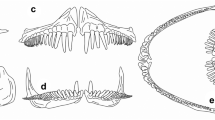Abstract
Cliona lampa Laubenfels (Porifera: Hadromerida), a common burrowing organism in Bermuda, has been used to study the method of sponge penetration into calcareous objects. To progress beyond the results obtained by previous authors, electron-microscope techniques, in addition to light-microscope observations, were employed. Burrowing patterns, fine structure of the tissue-substratum interface and of calcareous fragments removed by sponge activity are described on the basis of scanning electron microscopy. Cell types and cytological features have been identified by light and transmission electron microscope. One cell type of archeocyte origin is demonstrated; it carves out chips of calcium carbonate (and conchiolin) by means of filopodial extensions and etching secretions. The cells undergo plasmolysis during this process; the substratum chips are expelled through the exhalent canal system. It is calculated that only 2 to 3% of the eroded material is removed in solution.
Similar content being viewed by others
Literature Cited
Bagby, R. M.: The fine structure of pinacocytes in the marine sponge Microciona prolifera (Ellis and Solander). Z. Zellforsch. Abt. Histochem. 105, 579–594 (1970).
Borejevic, R. et C. Lévi: Etude au microscope électronique des cellules de l'éponge: Ophlitaspongia seriata (Grant), au cours de la réorganisation après dissociation. Z. Zellforsch. Abt Histochem. 64, 708–725 (1964).
Carriker, M. R. and E. H. Smith: Comparative calcibiocavitology: summary and conclusions. Am. Zool. 9, 1011–1020 (1969).
Carriker, M. R. and E. H. Smith and R. T. Wilce (Eds.): Penetration of calcium carbonate substrates by lower plants and invertebrates. Am. Zool. 9, 629–1020 (1969).
Clapp, W. F. and R. Kenk: Marine borers, an annotated bibliography, 1136 pp. Washington, D.C.: Office of Naval Research, Department of the Navy 1963.
Cobb, W. R.: Penetration of calcium carbonate substrates by the boring sponge, Cliona. Am. Zool. 9, 783–790 (1969).
Cotte, J.: Note sur le mode de perforation des cliones. C.r. Séanc. Soc. Biol. 54, 636–637 (1902).
Fawcett, D. W.: The cell, its organelles and inclusions. An atlas of fine structure, 448 pp. Philadelphia: W. B. Saunders Co. 1966.
Goreau, T. F. and W. D. Hartman: Boring sponges as controlling factors in the formation and maintenance of coral reefs. In: Mechanisms of hard tissue destruction, Ed. by R. F. Sognnaes. Washington, D.C.: Publs Am. Ass. Advmt Sci. 75, 25–54 (1963).
Grant, R. E.: Notice of a new zoophyte (Cliona celata Gr.) from the Firth of Forth. Edinb. New Phil. J. 1, 78–81 (1826).
Hartmann, W. D.: Natural history of the marine sponges of southern New England. Bull. Peabody Mus. nat. Hist. 12, 1–155 (1958).
Laubenfels, M. W. de: The Porifera of the Bermuda Archipelago. Trans. zool. Soc. Lond. 27, 1–154 (1950).
—: Sponges from the Gulf of Mexico. Bull. mar. Sci. Gulf Caribb. 2, 511–557 (1953).
Lévi, C.: Ultrastructure de la larve parenchymella de démosponge. 1. Mycale contarenii (Martens). Cah. Biol. mar. 5, 97–104 (1964).
Little, F. J., Jr.: The sponge fauna of the St. George's Sound, Apalachee Bay and Panama City regions of the Florida Gulf Coast. Tulane Stud. Zool. 11, 31–71 (1963).
Nassonov, N.: Zur Biologie und Anatomie der Clione. Z. wiss. Zool. 39, 295–208 (1883).
Neumann, A. C.: Observations on coastal erosion in Bermuda and measurements of the boring rate of the sponge, Cliona lampa. Limnol. Oceanogr. 11, 92–108 (1966).
Pang, R. K.: The systematics of some Jamaican excavating sponges. Postilla (In press).
Pavans de Ceccatty, M.: Ultrastructures et rapports des cellules mésenchymateuses de type nerveux de l'eponge Tethya lyncurium Lmk. Annls Sci. nat. (Zool. Biol. Animale) (sér. 12) 8, 577–614 (1966).
— et Y. Thiney: Microscopie électronique de la fibrogenèse cellulaire du collagène, chez l'éponge siliceuse Tethya lyncurium Lmk. C.r. hebd. Séanc. Acad. Sci., Paris 256, 5406–5408 (1963).
Rützler, K.: Bredin-Archbold-Smithsonian biological survey of Dominica: Burrowing sponges, genus Siphonodictyon Bergquist, from the Caribbean. Smithson. Contr. Zool. 77, 1–37 (1971).
Rützler, K.: The burrowing sponges of Bermuda. Smithson. Contr. Zool. (In press).
Rützler, K.: Participation of burrowing sponges in erosion and sediment production on the Bermuda platform. (In preparation).
Topsent, E.: Contribution à l'étude des clionides. Archs Zool. exp. gén. (sér. 2) 5, 1–165 (1887).
—: Etude monographique des spongiaries de France. III. Monaxonida (Hadromerina). Archs Zool. exp. gén. (sér. 3) 8, 1–331 (1900).
Vosmaer, G. C. J.: The sponges of the Bay of Naples. Porifera Incalaaria. With analyses of genera and studies in the variations of species, Part V. pp 321–456. The Hague: Martinus Nijhoff 1933.
Warburton, F. E.: The manner in which the sponge Cliona bores in calcareous objects. Can. J. Zool. 36, 555–562 (1958).
Wilson, H. V. and J. T. Penney: The regeneration of sponges (Microciona) from dissociated cells. J. exp. Zool. 56, 73–147 (1930).
Author information
Authors and Affiliations
Additional information
Communicated by O. Kinne, Hamburg
Supported by Smithsonian Research Foundation Fund 426242. Contribution No. 574, Bermuda Biological Station.
Rights and permissions
About this article
Cite this article
Rützler, K., Rieger, G. Sponge burrowing: Fine structure of Cliona lampa penetrating calcareous substrata. Marine Biology 21, 144–162 (1973). https://doi.org/10.1007/BF00354611
Accepted:
Issue Date:
DOI: https://doi.org/10.1007/BF00354611




